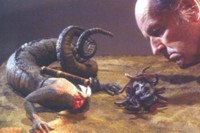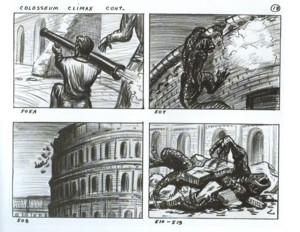| |
The Thunder ChildScience Fiction and Fantasy |
| |
|
|
The Thunder Child Book Reviews by Ryan Brennan
For years fans were given glimpses of Harryhausen?s production art in the pages of Famous Monsters of Filmland magazine (edited by his longtime friend Forrest J. Ackerman). There, the artist?s atmospheric sketches, dark and mysterious in the manner of Gustav Doré, would invite reverent scrutiny. Harryhausen describes how he achieved this effect by using a technique picked up from his mentor, King Kong creator Willis O?Brien. He would sketch the outlines of his subjects, sprinkling the entire drawing with powdered charcoal. After creating the highlights with an eraser he would then fill in the lines and dark areas. The effectiveness of this technique can be seen on page after page of this book in beautiful, satiny black & white reproductions. therFile VersionsWarning: Restoring an older version will overwrite the current file without backing it up. New ArchiveHarryhausen toiled for many years on his own. Printed literature on the subject of stop-motion, the building of stop-motion models and motion picture special effects was practically non-existent. Harryhausen persevered through trial and error, even mixing his own model paints because, at that time, none existed that were suitable for his work. With the help of his father, a machinist, metal armatures were manufactured and with his mother?s skills clothing and other fittings for his miniature people and sets were produced. (I have always been impressed with the support and encouragement Harryhausen received from his parents.)
Later, the highly evocative key art of Byron Crabbe and Mario Larrinaga would further fuel the young man?s desire to bring fantastic creatures to life. These artists would paint on glass the Dore? inspired jungles inhabited by Kong. Later, Harryhausen would come to own several of Crabbe?s and O?Brien?s drawings including a production book containing key drawings of all the major scenes in Obie?s unfinished feature Creation (1930), the project that led to King Kong. Storyboards for another "lost" O?Brien project, Gwangi (1941), were also acquired. Harryhausen would eventually meet his idol while O?Brien was working on yet another film that never flew, War Eagles (1939), a fantasy film that would truly have been of epic proportions. The authors take us through a tour of Harryhausen?s early projects and seminal work. He built dinosaurs from papier mache? and learned to sculpt marionettes with which he would stage elaborate programs. He created impressive latex masks (pictured in the book) and always, always kept drawing. He created his own series of fairytale short films, worked on George Pal?s Puppetoon series, spent WWII service in the employ of Frank Capra on his Why We Fight series and sculpted the model of Pvt. SNAFU that was used as a reference for cartoon animators.
An early project was inspired by a trip to South America. The idea was to mix a Mayan location with Greek mythology in a film to be called The Satyr (1946), a creature that was to serve as a forerunner of the Cyclops from The 7th Voyage of Sinbad (1958). The Mooncalf from First Men in the Moon (1964) goes back to a design conceived for his version of War of the Worlds (1949). The Homonculus was first hatched during The 3 Worlds of Gulliver (1960). And there were Harryhausen?s own abandoned projects. Force of the Trojans (1984) was meant to follow Clash of the Titans. Sinbad Goes to Mars (1981/2) and Sinbad and the Seven Wonders of the World (1981/2) never overcame script problems. The Adventures of Baron Munchausen (1938), Food of the Gods (1950 & 1961), R.U.R. (1945), The People of the Mist (1983) and The Deluge (1967) are more tantalizing titles that never saw the silver screen. Archive Name Back to Control PanelWeb Site .htaccess Editor Archive Gateway Disk Usage FTP FileManager Many, if not most, of these marvels are on display in the book. Reproduced in color and black & white, with frequent full pages, many spreading over two eye-filling pages, this 9 ?" x 11 ?" publication is generously packed with fantastic art. Here are illustrations by Crabbe and O?Brien, watercolor and charcoal and pencil production art from Mighty Joe Young. There is a bounteous section of color photographs and sketches for Harryhausen?s fairytales. There is an interesting series of pictures from Earth Vs. the Flying Saucers (1956) in which Harryhausen superimposes sketches of the spaceships and destruction of Washington D.C. over location photos, a technique he sometimes employed. A behind-the-scenes still from One Million Years B.C. (1966) shows the set-up for John Richardson? fight with the Allosaurus. A full page reproduction of a sketch from The Satyr demonstrates the link with Sinbad?s Cyclops.
And there is an entire section devoted exclusively to Harryhausen?s bronze work. Many of his creations have been revitalized, caught in active, dynamic poses. Here we see the bronze he created to sell the idea of Clash of the Titans to M-G-M. Sinbad battles the Dragon and duels with Kali. The Cyclops lunges forward. Last, but certainly not least, are photos detailing the work on his largest bronze, "Livingstone and the Lion", a larger-than-life recreation capturing the moment when the explorer/missionary?s shoulder is about to be engulfed by the charging lion he?s just shot. This work gives Harryhausen particular pleasure, especially since his wife, Diana, is the great-granddaughter of David Livingstone. Harryhausen, who is usually rather tight-lipped about the details of his special effects works, even mentions a few of his secrets. In Jason and the Argonauts (1963) he achieved the steaming ichor, the liquid that pours from the heel of the bronze giant Talos, by using cellophane on a revolving disc lit by a red light. When animating the giant crab in Mysterious Island (1961) Harryhausen could not use the traditional bolts that would secure the model to the animation stage. Instead, he had to run wires from the sharp, pointed appendages of the crustacean through the tabletop and secure them below the stage. For Mighty Joe Young, Harryhausen created plasticine lips that were animated frame by frame in order that Joe could drink from a bottle of booze offered him by three drunks. This book is a treasure trove for fans of Harryhausen. It is a book that will be pored over time and again and will stand apart from his films as a testimony to his great talent and imagination.
|
|





